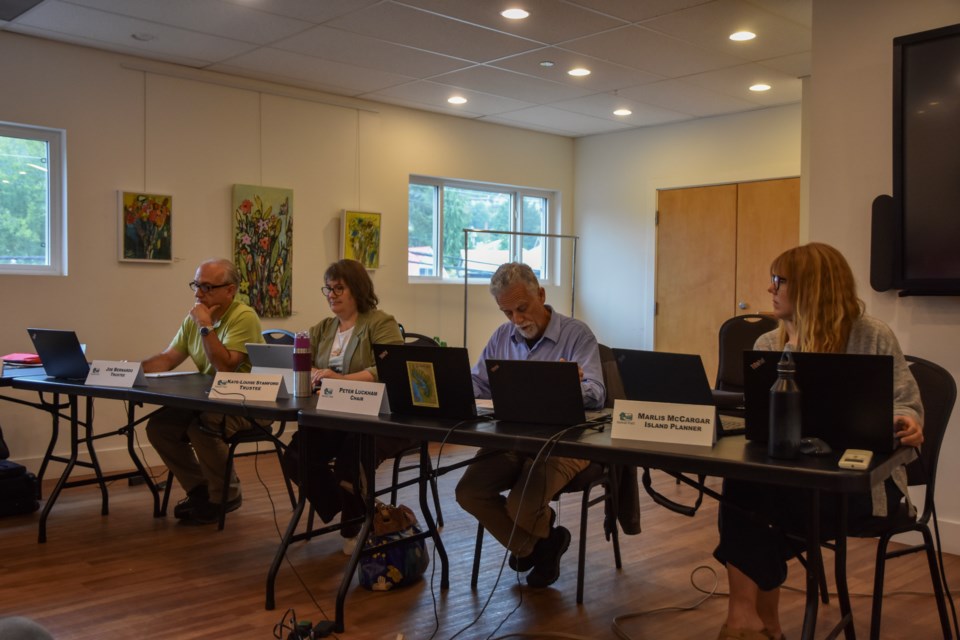More than 40 members of the public (including a puppy) trekked to Gibsons by bus, boat and ferry on July 31 to partake in the Keats Island public hearing for the Shoreline Protection Project, with people continuing to stream in as the meeting progressed.
The bylaws aim to establish a new shoreline development permit area (DPA) to protect the surrounding natural environment and amend building siting and size regulations regarding the natural boundary of the sea. New regulations for marine structures are also included. The bylaws, numbers 153 and 154, have been in the works for more than seven years.
The hearing was the public’s final opportunity to provide feedback in the process and ultimately, the conversation highlighted the complexities and challenges of balancing environmental protection with development in coastal areas.
The bylaws
Bylaw 153 would amend the Official Community Plan (OCP) to create a new shoreline development permit area, extending upland 15 metres from the natural boundary of the sea, the foreshore area and seaward 100 metres from the natural boundary.
Island Planner Marlis McCargar said the bylaw aligns with Islands Trust policies that, “strive to protect natural processes, habitats and species, minimize impacts of sensitive coastal environments and regulate development activity so that the loss of significant marine and coastal habitats or interference with coastal processes is reduced.”
Bylaw 154 would be to amend the Keats Island Land Use Bylaw.
McCargar said the bylaw would regulate structures permitted within the setback, increase setbacks between existing docks and lot lines, reduce the maximum float area of private docks and shared docks, reduce ramp width and reduce the maximum area of float or ramps permitted in the area.
She clarified that these regulations will only apply to new docks and marine infrastructure––none of it will be retroactively applied.
Like many islands in B.C., Keats Island is unique. McCargar explained the setback on Keats Island is seven and a half metres, instead of the usual 15 to 30, one of the smallest in the Trust Area. She noted that the setback will not change as initially proposed.
While these bylaws will restrict what property owners can do on their land that falls within the new DPA depending on their plans, McCargar explained exemptions are available and that permits within the area are usually granted in three to six months.
From the public
Speakers expressed concerns about cost, legal review and practical application of the bylaws, as well as the potential impact of the project on the community, with some expressing frustration with the time and location of the meeting, limited time for public input and the need for a quick vote.
More than 16 people voiced their opinion, with the majority being against the proposed bylaws.
Speaking about protecting eelgrass areas and preventing erosion, one member of the public said the changes were akin to “taking a massive hammer to a problem that can be dealt with with a tweezer.”
Many attendees raised issues with the time and location of the meeting, which is usually held either on Keats Island or in Vancouver on a weekend, saying they didn’t feel they had, “adequate public representation” from how challenging it was to get to Gibsons by 10 a.m. on a Wednesday.
Trustees explained they tried to schedule the meeting on Keats Island, but were unable to secure a venue with the available dates, which has historically been the biggest challenge in organizing meetings on the island.
McCargar said the fee for a development permit is roughly $1,040, to which many residents voiced frustration about the compounding costs on top of environmental surveys and other costs, remarking how expensive and slow the process has become.
One attendee cited their friend––a marine biologist––who told him the floats and docks on the island aren’t doing any damage and are creating environments underneath them, comparing the shade to that of a tree that rotates with the sun's movement.
Other residents voiced that since the shoreline has been so developed for decades, there is no justification for limiting what can be done on already-disturbed land.
Dan Rogers, a former Islands Trustee was one of few who spoke in favour of the bylaws. Prefacing that he was a trustee when this process started, he said it was time to get it done.
Reiterating that the process has gone on for more than seven years through many delays, he said, “People had an opportunity to write if they couldn't be here today, this is the public hearing, let's treat it with a public hearing and get the process done.”
Saying that Keats does not need a unique development process, Rogers said, “There is nothing more local or specific to a particular property than a DPA process because it addresses the issues on that specific property and addresses the environmental concerns and what the situation on the ground is.”
As enforcement is complaint-based, one attendee suggested trying to incentivize landowners to go along with the process instead of “using a stick,” as people living this remotely can do work under the radar by working in the evenings, weekends and so on to avoid awkward situations of neighbours monitoring each other.
Another recurring request from the public was for exemptions to be made on repairs on existing structures that will be outside the new permit area.
Deferred to the fall
Given the amount of feedback they received, Gambier Island Trustee Joe Bernardo motioned to defer the third reading of the bylaws until their next meeting on Oct 1, to allow them time to deliberate and consider the submissions given, which was unanimously passed.
Jordan Copp is the Coast Reporter’s civic and Indigenous affairs reporter. This reporting beat is made possible by the Local Journalism Initiative.

.png;w=120;h=80;mode=crop)
(1).png;w=120;h=80;mode=crop)
